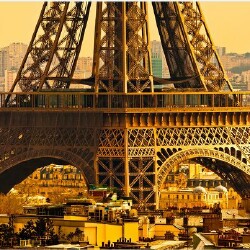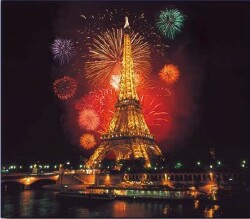Christmas is a very special time of year for Francophones around the world. Les marchés de Noël date back to the
fourteenth century in Germany, also in what is now known as the German-speaking region of France. The market was first called Le Marché de la Saint Nicolas. As far back as 1434, documentation regarding the Christmas market has been found from King Friedrich II de Saxe. One of the very first of its kind was a “Striezelmarkt” which was named after a dried fruit cake that was sold during this era. Later, during the sixteenth century, a reformation of these markets brought about a change in the market name to “Christkindlmarkt”, or “The Infant Jesus Market”, bringing even more religious reverence to the market’s meaning. These aptly named markets developed in eastern France, particularly in Strasbourg (in Alsace) in 1570.
Given the profound history of these markets, they have become well-known as places to find artisanal treasures, fine food, and festive celebrations. Christmas markets abound throughout France, found in most cities large and small, often on a main street of town or on a central city square. These markets are typically organized by a commune, and they may open as early as the middle of November, running all the way through the beginning of January. In a typical market, visitors may find vendors, Father Christmas, activities for the children and often an evening light show, an illumination of the town or city that takes place around nightfall.
A typical staple of any good marché is a vin chaud, that hot mulled wine concoction flavored with a bit of orange, cinnamon, star anise and occasionally a bit of ginger. Served in tents or market stands, in shops and restaurants and even street corners throughout France, it is as much a part of the holidays as Père Noël. One can also find those delicious honey-and-spice cakes known by their Alsacian name of lebkuchen, often dipped in chocolate or powdered sugar, another tradition from the northeastern part of France.
Christmas markets are steeped in rich, historical traditions and unusual gift items, giving the visitor a perfect reason to make a December trip to France.


 French music: how about the First Lady’s new album? Carla Bruni’s “Comme si de rien n’était” is soft and easy listening, or for a different style, try pop singer ZAZ, (album of the same name) whose sassy original sound has taken France by storm. Both available on Amazon.
French music: how about the First Lady’s new album? Carla Bruni’s “Comme si de rien n’était” is soft and easy listening, or for a different style, try pop singer ZAZ, (album of the same name) whose sassy original sound has taken France by storm. Both available on Amazon. Signature French cocktails: try a French martini made with the incomparable black raspberry liqueur crafted at the Château de la Sistière in the Loire Valley. Mix 15 ml of Chambord, 50 ml vodka, 60 ml fresh pineapple juice. C’est merveilleux!
Signature French cocktails: try a French martini made with the incomparable black raspberry liqueur crafted at the Château de la Sistière in the Loire Valley. Mix 15 ml of Chambord, 50 ml vodka, 60 ml fresh pineapple juice. C’est merveilleux! 


 Wondering where the French president lives and works? Right in the middle of Paris, in the Elysée Palace. In 1718, a town house was constructed on a plot of land in the then-sleepy area of Paris known as the Faubourg St-Honoré to serve as the residence of the Count of Evreux. Built and decorated between 1718 and 1722, the house was designed and laid out in accordance with the prevailing principles of contemporary architectural theory. At his death in 1753, the Comte left a town house that was admired by all his contemporaries, one of whom called it the finest country home in the neighbourhood of Paris. Passed on through the ages to various owners and occupiers, regal, powerful, socially connected and revolutionary, the palace has been transformed, redecorated, remodeled, modernized. In 1848, it was designed the official residence of the French president. Located at 55, rue du Faubourg St-Honore, the palace boasts beautiful private apartments, a presidential office, a wine cellar, a private florist, and magnificent English-style gardens. While it is not possible to tour the presidential palace, one can peek into the courtyard through the open gates on Wednesday mornings when the entire cabinet visits. If you’d like to get an idea of what the president eats, baker Rene Gerard St. Ouen brings fresh bread to the president twice daily; his boulangerie is located at 111 Boulevard Haussmann (metro Miromesnil, line 9). Take a marvelous virtual tour
Wondering where the French president lives and works? Right in the middle of Paris, in the Elysée Palace. In 1718, a town house was constructed on a plot of land in the then-sleepy area of Paris known as the Faubourg St-Honoré to serve as the residence of the Count of Evreux. Built and decorated between 1718 and 1722, the house was designed and laid out in accordance with the prevailing principles of contemporary architectural theory. At his death in 1753, the Comte left a town house that was admired by all his contemporaries, one of whom called it the finest country home in the neighbourhood of Paris. Passed on through the ages to various owners and occupiers, regal, powerful, socially connected and revolutionary, the palace has been transformed, redecorated, remodeled, modernized. In 1848, it was designed the official residence of the French president. Located at 55, rue du Faubourg St-Honore, the palace boasts beautiful private apartments, a presidential office, a wine cellar, a private florist, and magnificent English-style gardens. While it is not possible to tour the presidential palace, one can peek into the courtyard through the open gates on Wednesday mornings when the entire cabinet visits. If you’d like to get an idea of what the president eats, baker Rene Gerard St. Ouen brings fresh bread to the president twice daily; his boulangerie is located at 111 Boulevard Haussmann (metro Miromesnil, line 9). Take a marvelous virtual tour 





